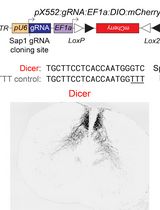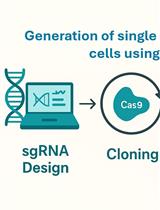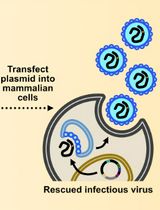- EN - English
- CN - 中文
Analysis of DNA Exchange Using Thymidine Analogs (ADExTA) in Trypanosoma cruzi
克氏锥虫中利用胸苷类似物进行DNA交换分析
发布: 2018年12月20日第8卷第24期 DOI: 10.21769/BioProtoc.3125 浏览次数: 4484
评审: Gal HaimovichNoelia LanderEmilia Krypotou
Abstract
Trypanosoma cruzi is a protozoan parasite belonging to the Trypanosomatidae family. Although the trypanosomatids multiply predominantly by clonal generation, the presence of DNA exchange in some of them has been puzzling researchers over the years, mainly because it may represent a novel form that these organisms use to gain variability. Analysis of DNA Exchange using Thymidine Analogs (ADExTA) is a method that allows the in vitro detection and measurement of rates of DNA exchange, particularly in trypanosomatid cells, in a rapid and simple manner by indirect immunofluorescence assay (IFA). The method can be used to detect DNA exchange within one trypanosomatid lineage or among different lineages by paired analysis. The principle of this assay is based on the incorporation of two distinguishable halogenated thymidine analogs called 5′-chloro-2′-deoxyuridine (CldU) and 5′-iodo-2′-deoxyuridine (IdU) during DNA replication. After mixing the two cell cultures that had been previously incorporated with CldU and IdU separately, the presence of these unusual deoxynucleosides in the genome can be detected by specific antibodies. For this, a DNA denaturation step is required to expose the sites of thymidine analogs incorporated. Subsequently, a secondary reaction using fluorochrome-labeled antibodies will generate distinct signals under fluorescence analysis. By using this method, DNA exchange verification (i.e., the presence of both CldU and IdU in the same cell) is possible using a standard fluorescence microscope. It typically takes 2-3 days from the thymidine analogs incorporation to results. Of note, ADExTA is relatively cheap and does not require transfections or harsh genetic manipulation. These features represent an advantage when compared to other time-consuming protocols that demand DNA manipulation to introduce distinct drug-resistance markers in different cells for posterior selection.
Keywords: DNA exchange (DNA交换)Background
Trypanosomatids parasites are single-celled eukaryotes within the supergroup Excavata (Adl et al., 2012). Among them, there are human pathogens responsible for causing several devastating diseases such as T. cruzi (etiological agent of Chagas disease, also called American trypanosomiasis), T. brucei (etiological agent of sleeping sickness, also called Human African trypanosomiasis), and Leishmania spp. (etiological agent of distinct forms of leishmaniasis). Altogether, these peculiar organisms are responsible for more than 50,000 deaths annually worldwide (Ponte-Sucre, 2016; Browne et al., 2017; da Silva et al., 2017b; Torres-Guerrero et al., 2017). Although trypanosomatids predominantly multiply by clonal generation through longitudinal binary fission, the presence of DNA exchange in these organisms, including T. cruzi and Leishmania spp., have been debated over the years (Gaunt et al., 2003; Alves et al., 2018). Due to the lack of practical and straightforward experiments and due to the difficulty of reproducing complex assays, DNA exchange still little explored, even though it may represent a novel and unknown form that trypanosomatids use to gain variability. However, a recent work developed by our group presented an elegant approach to detect DNA exchange in different strains of T. cruzi (Alves et al., 2018). In this study, we figured out higher rates of DNA exchange in naturally-occurring hybrid CL Brener strain (TcIV) relative to naturally-occurring non-hybrid Y strain (TcII). Also, this work pointed out that the recombinase Rad51 contributes significantly to the efficiency of this mechanism (Alves et al., 2018).
Here, we describe in detail the protocol used in this study to detect DNA exchange in trypanosomatids. We named it as Analysis of DNA Exchange using Thymidine Analogs (ADExTA). The principle of the method is based on the incorporation of two distinguishable halogenated thymidine analogs [e.g., 5′-chloro-2′-deoxyuridine (CldU) and 5′-iodo-2′-deoxyuridine (IdU)] into DNA during the S phase of the cell cycle. The presence of these unusual deoxynucleosides in the genome can be detected by specific antibodies after a DNA denaturation step using HCl, which will generate distinct signals after a secondary reaction using fluorochrome-labeled antibodies. This principle is the same used in the technique single-molecule analysis of DNA replication (Herrick and Bensimon, 1999), usually called DNA combing (Calderano et al., 2015; Stanojcic et al., 2016; da Silva et al., 2018). The method is rapid, relatively simple and provides a good overview of the presence of DNA exchange, as well as its rate. Of note, this protocol represents a considerable advantage when compared to other laborious approaches that require harsh genetic manipulation and is time-consuming, such as constructions using recombinant DNA to introduce distinct drug-resistance markers in different cells. By using this method, the presence of DNA exchange and its measurement can be carried out using a standard fluorescence microscope. Theoretically, this protocol can be applied to any organism that allows the incorporation of CldU/IdU, and it typically takes 2-3 days from the thymidine analogs incorporation to results. Of note, although thymidine analogs can be toxic for some cell types (Davidson and Kaufman, 1979; Hancock et al., 2009), in trypanosomatids they have been used apparently without showing any toxic effect (Elias et al., 2007; da Silva et al., 2013; Stanojcic et al., 2016; da Silva et al., 2017a).
Materials and Reagents
- Microtubes 1.5 ml (Axygen, Maxyclear, catalog number: MCT-150-C-S)
- Centrifuge tubes 15 ml (Corning, catalog number: CLS430791)
- Centrifuge tubes 50 ml (Corning, catalog number: CLS430290)
- Culture flasks 25 cm2 (Corning, canted neck, cap plug seal, catalog number: CLS430168)
- Syringe filter 0.22 μm (Sartori, Minisart Syringe filter, catalog number: 16534)
- Micropipette tips, 10 μl, 200 μl and 1,000 μl (Axygen, catalog numbers: T-300, T-200-Y and T-1000-B)
- Serological pipettes, 10 ml (Costar Sterile, catalog number: 4488)
- Microscope Slides (Knittel glass, non-color, catalog number: VA111101FKB.01)
- Coverslips (Knitell glass, 22 x 22 mm, catalog number: VD12222Y1A.01)
- Plastic coverslips (use a cut plastic pocket for binder)
- T. cruzi cell lines: Y strain (TcII) and CL Brener strain (TcIV)
- 5′-Iodo-2′-deoxyuridine (IdU) (Sigma-Aldrich, catalog number: I7125)
- 5′-Chloro-2′-deoxyuridine (CldU) (Abcam, catalog number: ab213715)
- Mouse α-IdU monoclonal antibody (BD, catalog number: 347580)
- Rat α-CldU monoclonal antibody (Accurate, catalog number: YSRTMCA2060GA)
- Goat α-mouse IgG1 secondary antibody, Alexa Fluor 568 (Thermo Scientific, catalog number: A-21124)
- Goat α-rat IgG (H + L) secondary antibody, Alexa Fluor 488 (Thermo Scientific, catalog number: A-11006)
- Paraformaldehyde (Sigma-Aldrich, catalog number: 158127)
- Poly-L-lysine hydrochloride (Sigma-Aldrich, catalog number: P2658)
- Bovine serum albumin (Sigma-Aldrich, catalog number: 05470)
- Triton X-100 (Sigma-Aldrich, catalog number: T8787)
- NaCl (Sigma-Aldrich, catalog number: S9888)
- KCl (Sigma-Aldrich, catalog number: P9541)
- Na2HPO4 (Sigma-Aldrich, catalog number: 255793)
- KH2PO4 (Merck, catalog number: 104873)
- D-Glucose (Sigma-Aldrich, catalog number: G8270)
- Liver Infusion broth (BD, catalog number: 226920)
- Tryptose (Sigma-Aldrich, catalog number: 70937)
- Hemin (Sigma-Aldrich, catalog number: H9039)
- Triethanolamine (Sigma-Aldrich, catalog number: 90279)
- Fetal Bovine Serum (Fisher Scientific, catalog number: 10500056)
- Penicillin G sodium salt (Sigma-Aldrich, catalog number: 13752)
- Streptomycin sulfate salt (Sigma-Aldrich, catalog number: S9137)
- Boric Acid (Sigma-Aldrich, catalog number: B6768)
- Sodium tetraborate (Sigma-Aldrich, catalog number: 221732)
- NaOH (Merck, catalog number: 1064980500)
- Vectashield Mounting Medium with DAPI (Vector Labs, catalog number: H-1200)
- Hydrochloric acid fuming 37% (Merck, catalog number: 100317)
- Nail varnish (any brand, preferably colorless)
- Alkalinized water (see Recipes)
- Phosphate buffered saline (1x PBS) (see Recipes)
- Liver Infusion Tryptose (LIT) medium (see Recipes)
- 5′-chloro-2′-deoxyuridine solution (CldU-S) (see Recipes)
- 5′-iodo-2′-deoxyuridine solution (IdU-S) (see Recipes)
- Fixation buffer (FB) (see Recipes)
- Poly-L-lysine solution (PLS) (see Recipes)
- Permeabilization solution (PS) (see Recipes)
- Denaturation buffer (DB) (see Recipes)
- Neutralization buffer (NB) (see Recipes)
- Blocking solution (BS) (see Recipes)
Equipment
- Microcentrifuge (Eppendorf, model: 5424 R)
- Motorized pipet dispenser (Fisher Scientific, Fisherbrand, catalog number: 03-692-172)
- Water bath (Cientec, model: CT-226)
- Incubator BOD (Vitrex, model: NI1705)
- Fluorescence Microscope [Olympus, model: BX51, coupled to an XM10 digital camera. Filters specifications: U-MWU2 (excitation = 330-385 nm; emission = 420 nm), U-MWIBA3 (excitation = 460-495 nm; emission = 510-550 nm), and U-MWG2 (excitation = 510-550 nm; emission = 590 nm)]
- Micropipettes (Gilson, models: Pipetman P10, P20, P200 and P1000)
- Centrifuge (Eppendorf, model: 5810 R), equipped with 4 x 250 ml Swing-Bucket Rotor
- Neubauer chamber with cover glass (Sigma-Aldrich, model: Bright-LineTM Hemacytometer)
- Biosafety Class II A2 cabinet (Pachane, model: PA 700)
- pH meter (Gehaka, model: PG1800)
- Autoclave
Software
- Olympus Cell F software (Olympus, version 5.1.2640)
- ImageJ (NIH, version 1.47t)
- Microsoft Excel (Microsoft Office-any version) or GraphPad Prism (GraphPad software, Inc.)
Procedure
文章信息
版权信息
© 2018 The Authors; exclusive licensee Bio-protocol LLC.
如何引用
da Silva, M. S., Marin, P. A., Repolês, B. M., Elias, M. C. and Machado, C. R. (2018). Analysis of DNA Exchange Using Thymidine Analogs (ADExTA) in Trypanosoma cruzi. Bio-protocol 8(24): e3125. DOI: 10.21769/BioProtoc.3125.
分类
微生物学 > 微生物生物化学 > DNA
分子生物学 > DNA > DNA 重组
分子生物学 > DNA > DNA 标记
您对这篇实验方法有问题吗?
在此处发布您的问题,我们将邀请本文作者来回答。同时,我们会将您的问题发布到Bio-protocol Exchange,以便寻求社区成员的帮助。
提问指南
+ 问题描述
写下详细的问题描述,包括所有有助于他人回答您问题的信息(例如实验过程、条件和相关图像等)。
Share
Bluesky
X
Copy link














